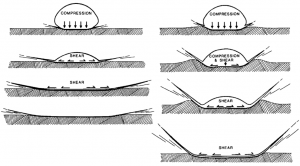5.3 Raindrop Impact
Raindrops whose fall is not interrupted by vegetation or plant residues can strike the soil surface like miniscule bombs going off. The greater the speed and mass of the drop, the greater the force of the impact. The maximum speed a given drop can reach during its fall, its terminal velocity, increases as the drop size increases. Small water droplets in the atmosphere with diameters of 0.1 mm have terminal velocities of only 0.27 m s-1, while large raindrops with diameters of 5.8 mm have terminal velocities of 9.2 m s-1 [21]. When raindrops strike the soil surface at high speed, soil can be splashed into the air by these drop impacts, and this soil splash contributes significantly to the spread of plant pathogens and to soil erosion and soil crust formation, processes which we will consider in subsequent sections [22, 23].

The amount of soil splash generated by raindrop impact is influenced, not only by the drop size and speed, but also by the strength of the soil. Soil strength is the maximum stress that a particular soil body can bear without failing. When a raindrop impacts high strength soil, the drop does not appreciably penetrate the soil and the drop spreads radially across the soil surface, resulting in relatively little soil splash [24]. In contrast, when a drop first impacts low strength soil, the soil surface is deformed under the drop, raising a ring-shaped bulge of soil around the edge of the drop (Fig. 5‑9). Assuming that the soil is saturated, the soil volume and density are unchanged because there is insufficient time during the impact for the soil to drain and water is essentially incompressible. As the impact continues, the force of the spreading water blows out the sides of the cavity splashing soil into the air. Lower soil strength results in a larger cavity and surrounding bulge, greater soil detachment, and greater splash angle relative to the soil surface. This soil detachment often initiates the processes of soil crusting, which we will consider here, and soil erosion, which we will consider in a later chapter.


